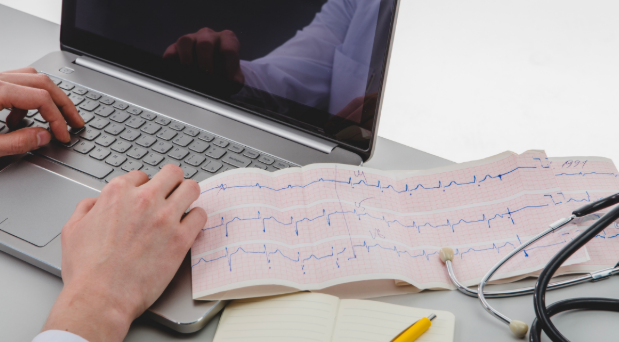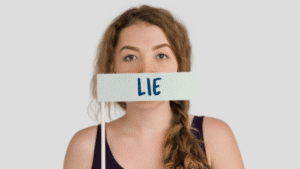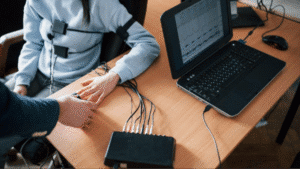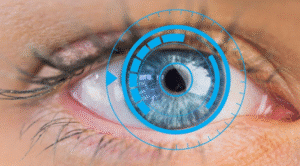The polygraph is a century-old lie detection technique that’s still rapidly evolving.
Like most technologies, original lie detector instruments were simplistic devices with limited capabilities. This equipment monitored a few physiological responses associated with lying, making them less reliable at detecting deception.
However, the polygraph technology has seen continued perfection over time, earning it wider legal and scientific acceptance. Here’s how polygraphs have evolved since the 1990s.

Polygraphs Before the ‘90s
One of the earliest versions of the lie detector test equipment appeared in the late 1800s.
The device, known as the hydrosphygmograph, was developed by Cesare Lombroso. It measured fluctuations in blood pressure and pulse rate.
In 1915, William Marston developed an instrument that monitored changes in systolic blood pressure consistent with lying. But like Lombroso’s hydrosphygmograph, Marston’s polygraph instrument had limited capabilities.
The first closest iteration of the modern polygraph instrument came out in 1921. Designed by John A. Larson, this device tracked changes in respiration, heart rate, and blood pressure with incredible accuracy.
Interest in lie detector tests began to surge shortly after Larson’s invention.
In 1923, the first recorded polygraph exam in America was administered in the Frye v. United States case. The test results were sadly declined for falling short of evidence admissibility. However, this polygraph exam inspired the development of the Frye Standard, which requires expert opinions to be widely accepted within relevant scientific communities as a minimum condition for evidence admissibility.
In 1935, Leonarde Keeler, who co-invented the famous Keeler polygraph, conducted a lie detector evaluation on two murder suspects in Wisconsin. The findings were accepted this time around and played a key role in convicting the suspects.
In 1939, Keeler incorporated galvanic skin response (GSR) sensors into his lie detector instrument, expanding the device’s capabilities.

Polygraphs from the ‘90s
Advancements in Polygraph Hardware
The ‘90s witnessed significant advancements in polygraph technology, thanks to the advent of computer engineering. After working with analog lie detectors for decades, examiners were ready to embrace digital polygraphs.
Digital lie detector equipment utilizes computer algorithms to track an examinee’s physiological reactions during polygraph questioning. The data is compared against pre-recorded baselines in real time, reducing the time initially required to compile the final report.
The advent of computerized polygraph instruments also enhanced the accuracy of lie detector tests. It minimized human error and examiner bias, making polygraph evaluations difficult to beat.
Besides, computerized systems eased the process of report preparation, storage, and sharing. They enable examiners to analyze the data over time and uncover what they might have missed during initial report preparation.
One of the earliest computerized polygraph exams is the Test for Espionage and Sabotage (TES). Although the U.S. government developed this technique in the 1880s, its significance became more apparent with the growing adoption of digital lie detector tests in the 1990s.
Changes in Legal Admissibility
Polygraph testing has undergone major shifts in its legal admissibility since the 1990s.
It all began with the promulgation of the Military Rule of Evidence 707 (a) by President George H. W. Bush in 1991, which essentially made lie detector reports inadmissible in court.
Two years later, the Daubert v. Merrell Dow Pharmaceuticals, Inc. lawsuit changed the course of polygraph history forever.
This case saw the development of the Daubert standard for evidence admissibility. According to the standard, a theory or technique is legally acceptable if it;
- Has been published and peer-reviewed
- Can be or has been tried and tested
- Has a minimal error rate
- Is widely acceptable within its relevant scientific community
In 1996, the U.S. Court of Appeals declared as unconstitutional the 1991 promulgation of the Military Rule of Evidence 707 (a). Polygraph reports were now acceptable in certain jurisdictions, especially where defendants sought to strengthen their testimonies.
1998 saw yet another historic development in polygraph testing, after the U.S. Supreme Court overturned earlier high court rulings on the constitutionality of the Military Rule of Evidence during the United States v. Scheffer case.
Following this determination, polygraph results became legally inadmissible by default.
Note that several jurisdictions allow polygraphs during criminal and civil trials. However, both parties must agree to the tests. Besides, the findings can only be used to corroborate other pieces of evidence or witness testimonies.

Journeying Into the Future of Polygraph Tests
Since the 1990s, polygraph technology has advanced significantly in terms of approach & instrumentation. One of the most significant advances has been the implementation of validated testing and scoring procedures, which has radically altered how polygraph results are understood and applied.
In the 1990s, polygraph examinations relied significantly on examiner interpretation, with forms such as the Control Question Test (CQT) lacking uniform scoring. This subjective approach frequently created questions regarding consistency and reliability. Modern polygraphy, on the other hand, focuses on evidence-based procedures, particularly the use of empirically proven techniques such as the Test for Espionage and Sabotage (TES) and the Directed Lie Test (DLT), both of which are supported by scientific field research.
Scoring methods have likewise evolved from manual chart reviews to numerical scoring systems based on proven algorithms. These approaches, such as the Empirical Scoring System (ESS) created by the Department of Defense Polygraph Institute (DoDPI), allow for consistent interpretations across examiners and agencies, eliminating prejudice and enhancing accuracy. Today, many polygraph programs follow protocols established by organizations such as the American Polygraph Association (APA), resulting in increased scientific rigor.

Keeping Tabs With Key Polygraph Innovations and Advancements
Lie detector tests have seen a significant evolution from the ‘90s, a trend that’s likely to persist into the foreseeable future.
Advancements in polygraphs have not only focused on improving the technical capabilities of the lie detector. They also encompass concerted efforts by industry stakeholders to pitch polygraph exams as a credible way of detecting deception. While lie detector tests are far from perfect, those conducted by examiners using modern polygraph equipment can yield pretty high accuracy scores.






